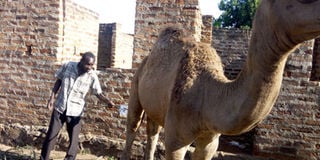Busia residents drink camel urine to treat diseases

Source. Mr Ali Mukaaza, one of the residents of Arubaine Village in Busia Town, taps urine from a camel on October 15. PHOTO BY DAVID AWORI
What you need to know:
- Dr Christopher Kato, the in-charge of Dabani hospital, acknowledged that the practice of using camel products to treat diseases is a common practice in the Arab world countries, especially Yemen.
- Laboratory studies carried out at King Abdulaziz University in Jeddah Saudi Arabia, indicate that camel waste contains metabolites such as Canavanine, which have a potent activity against cancer, causing tumour cells.
Residents in the remote village of Arubaine in Busia Municipality have resorted to drinking camel urine to treat diseases instead of visiting health facilities.
The residents say the animal’s waste can treat diseases such as cancer, diabetes, and high blood pressure, among others.
According to the locals, camels feed on rare tree species that have bitter substances, which are medicinal. For instance, the locals use camel dung to treat skin diseases while the fat, extracted from its meat, is used to treat measles.
This has made camel products a treasure in the area. Men, women and children line up and patiently wait for hours for the camels to urinate so that they can tap the waste.
A litre of camel urine now goes for Shs25,000 while a 300 millilitre bottle goes for Shs8,000. Camel fat sells between Shs20,000 and Shs150,000 depending on the quantity.
Mr Jaberi Kalifani Kanga, one of the residents, who administers the camel products to patients in the area, said many have recovered from several ailments after having a few doses of the camel product.
“I have for some time been using camel urine, fat and dung to treat patients who are diagnosed with cancer, high blood pressure, diabetes, measles and those with skin diseases and many come back testifying that they have regained their health,” Mr Kanga said at the weekend.
He said to ensure that the products are safe before administering, camel dung has to be roasted and then crashed to kill any possible bacteria while for the urine, ginger is applied as a preservative.
Ms Masitula Nantume, another resident, said: “I have been extracting oil from camel meat for some time and using it to treat measles and diabetes, among other diseases.”
Mr Ali Mukaaza said his mother, who had been bedridden with diabetes recovered after she was introduced to the camel urine treatment.
We have not, however, independently verified if the said patients got cured from the diseases.
Mr Emmery Mbaha, a public health expert, however, noted that camel dung may contain dangerous bacteria which cause tetanus if smeared on open wounds.
“I would not recommend humans using camel urine and dung because they risk exposure to so many diseases,” Mr Mbaha said.
Mr Emmanuel Ainebyoona, the public relations officer at the Ministry of Health, said: “What the residents are doing is risky because before they conclude that the camel products heal diseases, there must be a scientific study.”
Research
Laboratory studies carried out at King Abdulaziz University in Jeddah Saudi Arabia, indicate that camel waste contains metabolites such as Canavanine, which have a potent activity against cancer, causing tumour cells.
The urine was also found to contain Benzene Propanoic acid, which has antiplatelet activity, with possible application in the treatment of blood clotting and various heart conditions.
Dr Christopher Kato, the in-charge of Dabani hospital, acknowledged that the practice of using camel products to treat diseases is a common practice in the Arab world countries, especially Yemen.
He, however, said: “There should be clinical research on this products to establish their curative properties and the dosage, otherwise patients, who use these type of treatment risk serious health complications.”
He explained that in 2015, in the Arabian peninsular, there was an outbreak of the Middle East Respiratory Syndrome in communities that used camel products.




